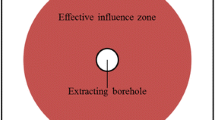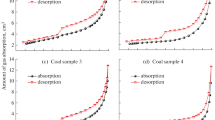Abstract
More and more gas extraction in deep coal seam is conducted under extreme geological conditions. The coal permeability determines the efficiency of gas extraction. To research the evolution of permeability and gas seepage in deep coal seam under three-dimensional (3D) stress condition, a permeability model (DCTDS model) was established by introducing the ratio of internal swelling and the elastic modulus reduction ratio under 3D stress. The influence of adsorption–desorption and effective stress on fracture aperture was considered in the DCTDS model. Subsequently, the DCTDS model was validated. Sensitivity analysis of parameters was conducted based on the laboratory test data under various boundary conditions. The results demonstrate that the change of coal permeability is effectively presented by the DCTDS model. The coal permeability decreased more with increasing pressure when the porosity and Biot’s coefficient were smaller in the dominant range of adsorption swelling. The coal permeability increased more when the porosity, Poisson’s ratio, and ratio of internal swelling were smaller in the dominant range of effective stress. Finally, based on the constructed DCTDS model, gas extraction in deep coal seams was simulated. The extraction effect was improved with smaller borehole spacing, and elastic modulus, Poisson’s ratio of coal. The extraction effect became more notable with larger borehole aperture, Biot’s coefficient, and initial permeability. The gas extraction efficiency decreased gradually with extension of extraction time.


























Similar content being viewed by others
Notes
* 1 psia = 6.89476 kPa.
*1 mD = 9.869233 × 10−16 m2
References
Bhapkar, P. V., Pradhan, S. P., Chandra, D., Hazra, B., & Vishal, V. (2023). Systematic pore characterization of sub-bituminous coal from Sohagpur coalfield, central India using gas adsorption coupled with X-ray scattering and high-resolution imaging. Energy & Fuels, 37(13), 9297–9308.
Biot, M. A. (1941). General theory of three-dimensional consolidation. Journal of Applied Physics, 12(2), 155–164.
Chen, Z., Liu, J., Pan, Z., Connell, L. D., & Elsworth, D. (2012). Influence of the effective stress coefficient and sorption-induced strain on the evolution of coal permeability: Model development and analysis. International Journal of Greenhouse Gas Control, 8, 101–110.
Connell, L. D., Lu, M., & Pan, Z. (2010a). An analytical coal permeability model for tri-axial strain and stress conditions. International Journal of Coal Geology, 84(2), 103–114.
Connell, L. D., Pan, Z., Lu, M., Heryanto, D., & Camilleri, M. (2010b). Coal permeability and its behaviour with gas desorption, pressure and stress. SPE Asia Pacific Oil and Gas Conference and Exhibition.
Cui, X. J., & Bustin, R. M. (2005). Volumetric strain associated with methane desorption and its impact on coalbed gas production from deep coal seams. Aapg Bulletin, 89(9), 1181–1202.
Dawson, G. K. W., Golding, S. D., Esterle, J. S., & Massarotto, P. (2012). Occurrence of minerals within fractures and matrix of selected Bowen and Ruhr Basin coals. International Journal of Coal Geology, 94, 150–166.
Gray, I. (1987). Reservoir engineering in coal seams: Part 1—the physical process of gas storage and movement in coal seams. SPE Reservoir Engineering, 2(1), 28–34.
Guo, P., Cheng, Y., Jin, K., Li, W., Tu, Q., & Liu, H. (2014). Impact of effective stress and matrix deformation on the coal fracture permeability. Transport in Porous Media, 103(1), 99–115.
Hol, S., & Spiers, C. J. (2012). Competition between adsorption-induced swelling and elastic compression of coal at CO2 pressures up to 100MPa. Journal of the Mechanics and Physics of Solids, 60(11), 1862–1882.
Jiang, C., Zhao, Z., Zhang, X., Liu, J., Elsworth, D., & Cui, G. (2020). Controlling effects of differential swelling index on evolution of coal permeability. Journal of Rock Mechanics and Geotechnical Engineering, 12(3), 461–472.
Li, J., & Li, B. (2021). Modeling of anisotropic coal permeability under the effects of matrix-fracture interaction. Journal of Natural Gas Science and Engineering, 93, 104022.
Liu, H.-H., & Rutqvist, J. (2010). A new coal-permeability model: Internal swelling stress and fracture–matrix interaction. Transport in Porous Media, 82(1), 157–171.
Liu, J., Chen, Z., Elsworth, D., Miao, X., & Mao, X. (2010a). Evaluation of stress-controlled coal swelling processes. International Journal of Coal Geology, 83(4), 446–455.
Liu, J., Chen, Z., Elsworth, D., Miao, X., & Mao, X. (2010b). Linking gas-sorption induced changes in coal permeability to directional strains through a modulus reduction ratio. International Journal of Coal Geology, 83(1), 21–30.
Liu, T., Lin, B., & Yang, W. (2017). Impact of matrix–fracture interactions on coal permeability: Model development and analysis. Fuel, 207, 522–532.
Lu, S., Cheng, Y., & Li, W. (2016). Model development and analysis of the evolution of coal permeability under different boundary conditions. Journal of Natural Gas Science and Engineering, 31, 129–138.
Palmer, I., & Mansoori, J. (1998). How permeability depends on stress and pore pressure in coalbeds: A new model. SPE Reservoir Evaluation & Engineering, 1(6), 539–544.
Pan, Z., & Connell, L. D. (2012). Modelling permeability for coal reservoirs: A review of analytical models and testing data. International Journal of Coal Geology, 92, 1–44.
Pan, Z., Connell, L. D., & Camilleri, M. (2010). Laboratory characterisation of coal reservoir permeability for primary and enhanced coalbed methane recovery. International Journal of Coal Geology, 82(3–4), 252–261.
Peng, Y., Liu, J., Pan, Z., Connell, L. D., Chen, Z., & Qu, H. (2017). Impact of coal matrix strains on the evolution of permeability. Fuel, 189, 270–283.
Perera, M. S. A., Ranjith, P. G., & Choi, S. K. (2013). Coal cleat permeability for gas movement under triaxial, non-zero lateral strain condition: A theoretical and experimental study. Fuel, 109, 389–399.
Pini, R., Ottiger, S., Burlini, L., Storti, G., & Mazzotti, M. (2009a). CO2 storage through ECBM recovery: An experimental and modeling study. Energy Procedia, 1(1), 1711–1717.
Pini, R., Ottiger, S., Burlini, L., Storti, G., & Mazzotti, M. (2009b). Role of adsorption and swelling on the dynamics of gas injection in coal. Journal of Geophysical Research-Solid Earth, 114, B04203.
Robertson, E. P., & Christiansen, R. L. (2007). Modeling laboratory permeability in coal using sorption-induced-strain data. SPE Reservoir Evaluation & Engineering, 10(3), 260–269.
Rong, T., Liu, K., & Guan, C. (2022). Evolution of internal swelling coefficient under different geometric conditions and its influence on gas drainage. Natural Resources Research, 31(2), 1027–1044.
Salmachi, A., Rajabi, M., Wainman, C., Mackie, S., McCabe, P., Camac, B., & Clarkson, C. (2021). History, geology, in situ stress pattern, gas content and permeability of coal seam gas Basins in Australia: A review. Energies, 14(9), 2651.
Seidle, J. P., Jeansonne, M. W., & Erickson, D. J. (1992). Application of matchstick geometry to stress dependent permeability in coals. SPE Rocky Mountain Regional Meeting.
Seidle, J. R., & Huitt, L. G. (1995). Experimental measurement of coal matrix shrinkage due to gas desorption and implications for cleat permeability increases. International Meeting on Petroleum Engineering.
Shi, J. Q., & Durucan, S. (2004). Drawdown induced changes in permeability of coalbeds: A new interpretation of the reservoir response to primary recovery. Transport in Porous Media, 56(1), 1–16.
Terzaghi, K. V. (1923). Die berechnung der durchassigkeitsziffer des tones aus dem verlauf der hydrodynamischen spannungserscheinungen. Sitzungsber. Akad. Wiss. Math. Naturwiss. Kl. Abt., 2A(132), 105–124.
Vishal, V., & Chandra, D. (2022). Mechanical response and strain localization in coal under uniaxial loading, using digital volume correlation on X-ray tomography images. International Journal of Rock Mechanics and Mining Sciences, 154, 105103.
Wang, C., Zhang, J., Chen, J., Zhong, R., Cui, G., Jiang, Y., Liu, W., & Chen, Z. (2021). Understanding competing effect between sorption swelling and mechanical compression on coal matrix deformation and its permeability. International Journal of Rock Mechanics and Mining Sciences, 138, 104639.
Wang, J. G., Liu, J., & Kabir, A. (2013). Combined effects of directional compaction, non-Darcy flow and anisotropic swelling on coal seam gas extraction. International Journal of Coal Geology, 109–110, 1–14.
Wang, K., Zang, J., Wang, G., & Zhou, A. (2014). Anisotropic permeability evolution of coal with effective stress variation and gas sorption: Model development and analysis. International Journal of Coal Geology, 130, 53–65.
Xie, H., Xie, J., Gao, M., Zhang, R., Zhou, H., Gao, F., & Zhang, Z. (2015). Theoretical and experimental validation of mining-enhanced permeability for simultaneous exploitation of coal and gas. Environmental Earth Sciences, 73(10), 5951–5962.
Yan, F., Xu, J., Peng, S., Zou, Q., Zhou, B., Long, K., & Zhao, Z. (2020). Breakdown process and fragmentation characteristics of anthracite subjected to high-voltage electrical pulses treatment. Fuel, 275, 117926.
Yuan, L. (2016). Control of coal and gas outbursts in Huainan mines in China: A review. Journal of Rock Mechanics and Geotechnical Engineering, 8(4), 559–567.
Zhang, J., Standifird, W. B., Roegiers, J. C., & Zhang, Y. (2007). Stress-dependent fluid flow and permeability in fractured media: From lab experiments to engineering applications. Rock Mechanics and Rock Engineering, 40(1), 3–21.
Zhao, D., Liu, J., & Pan, J.-T. (2018). Study on gas seepage from coal seams in the distance between boreholes for gas extraction. Journal of Loss Prevention in the Process Industries, 54, 266–272.
Zhao, Y., Hu, Y., Wei, J., & Yang, D. (2003). The experimental approach to effective stress law of coal mass by effect of methane. Transport in Porous Media, 53(3), 235–244.
Zhao, Y., Lin, B., Liu, T., Kong, J., & Zheng, Y. (2020). Gas flow in hydraulic slotting-disturbed coal seam considering stress relief induced damage. Journal of Natural Gas Science and Engineering, 75, 103160.
Zhao, Y., Zhao, Y., Liu, J., Wei, M., Huang, Y., & Jiang, C. (2023). Coal permeability behaviors and non-uniform deformations under various boundary conditions: Part 2—Modelling study. Fuel, 343, 127914.
Zhou, H. W., Rong, T. L., Wang, L. J., Mou, R. Y., & Ren, W. G. (2020). A new anisotropic coal permeability model under the influence of stress, gas sorption and temperature: Development and verification. International Journal of Rock Mechanics and Mining Sciences, 132, 104407.
Zhou, H. W., Zhao, J. W., Su, T., Zhang, L., Zhong, J. C., & Liu, Z. L. (2021). Characterization of gas flow in backfill mining-induced coal seam using a fractional derivative-based permeability model. International Journal of Rock Mechanics and Mining Sciences, 138, 104571.
Zhou, Y., Li, Z., Yang, Y., Zhang, L., Qi, Q., Si, L., & Li, J. (2016). Improved porosity and permeability models with coal matrix block deformation effect. Rock Mechanics and Rock Engineering, 49(9), 3687–3697.
Acknowledgments
This work was supported by the National Natural Science Foundation of China (Nos. 52004081, 52174175), the Key Scientific Research Project of Higher Education Institutions of Henan Province (No. 21A440005), the research fund of Henan Key Laboratory for Green and Efficient Mining & Comprehensive Utilization of Mineral Resources (Henan Polytechnic University), the opening project of Henan Key Laboratory of Underground Engineering and Disaster Prevention (Henan Polytechnic University), the Natural Science Foundation of Henan Polytechnic University (No. B2020-34), the Key R & D and promotion projects in Henan Province (Nos. 212102310010, 232102321128), the research fund of Jiaozuo Road Traffic and Transportation Engineering and Technology Research Center (No. JRTT2023008). The financial supports are gratefully acknowledged.
Author information
Authors and Affiliations
Corresponding author
Ethics declarations
Conflict of Interest
The authors declare that they have no known competing financial interests or personal relationships that could have appeared to influence the work reported in this paper.
Rights and permissions
Springer Nature or its licensor (e.g. a society or other partner) holds exclusive rights to this article under a publishing agreement with the author(s) or other rightsholder(s); author self-archiving of the accepted manuscript version of this article is solely governed by the terms of such publishing agreement and applicable law.
About this article
Cite this article
Rong, T., Liu, P., Wang, J. et al. Evolution of Permeability and Gas Seepage in Deep Coal Under 3D Stress. Nat Resour Res 33, 765–791 (2024). https://doi.org/10.1007/s11053-023-10306-0
Received:
Accepted:
Published:
Issue Date:
DOI: https://doi.org/10.1007/s11053-023-10306-0




